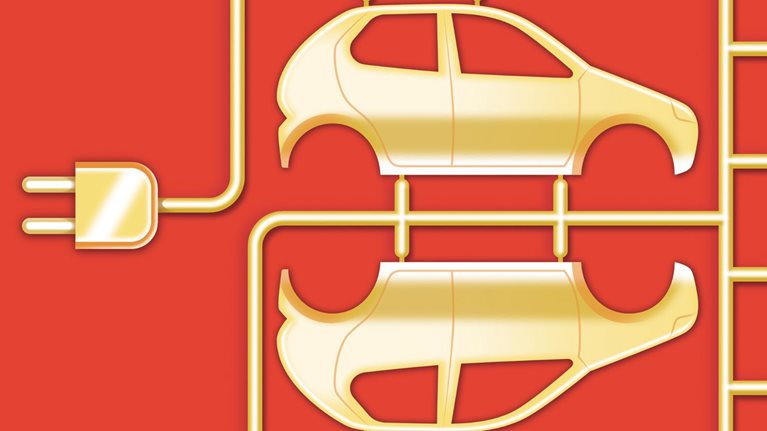Most experts agree that prices for energy storage will fall in coming years, but disagree over how far and how quickly. This is an important debate because a significant drop in battery prices could have wide-ranging effects across industries and society itself. In particular, cheaper batteries could enable the broader adoption of electrified vehicles, potentially disrupting the transportation, power, and petroleum sectors.
To inform the debate, we developed a detailed, bottom-up “should cost” model that estimates how automotive lithium-ion battery prices could evolve through 2025. Our analysis indicates that the price of a complete automotive lithium-ion battery pack could fall from $500 to $600 per kilowatt hour (kWh) today to about $200 per kWh by 2020 and to about $160 per kWh by 2025.1 In the United States, with gasoline prices at or above $3.50 a gallon, automakers that acquire batteries at prices below $250 per kWh could offer electrified vehicles competitively, on a total-cost-of-ownership basis, with vehicles powered by advanced internal-combustion engines (exhibit). 2
The interaction of battery and fuel costs will determine the size of the market for electric vehicles.

Of course, the pace of adoption will hinge on a range of factors in addition to battery prices. Macroeconomic and regulatory conditions, the performance and reliability of the vehicles, and customer preferences are important. And the rate at which automakers realize lower battery prices could vary by three to five years—the length of a product-development cycle—depending on the investment and power train–portfolio strategies these companies pursue.
Moreover, the emergence of cheaper batteries will probably spur further innovation in other technologies, such as internal-combustion engines. These advances would increase the probability that the broader economics of transportation will be reshaped over the next decade—no matter which technology prevails.
The path to savings
The model we developed, disaggregating the price of automotive battery packs into more than 40 underlying drivers,3 accounts for expected changes in areas such as materials technology and manufacturing, as well as overhead costs and margins for various segments of the value chain. This component-by-component perspective on future battery prices rests on a foundation of primary research, including interviews with experts in industry, academia, and government.
Our work suggests that three factors could accelerate the day when electrified vehicles become more compelling alternatives—at least on a total-cost-of-ownership basis—to vehicles powered by internal-combustion engines.
Manufacturing at scale. Scale effects and manufacturing productivity improvements, representing about one-third of the potential price reductions through 2025, could mostly be captured by 2015. Savings will come largely from improving manufacturing processes, standardizing equipment, and spreading fixed costs over higher unit volumes. New plants could therefore be significantly more productive than those in operation before 2010–11.
Lower components prices. Reductions in materials and components prices, representing about 25 percent of the overall savings opportunity, could mostly be captured by 2020. Under competitive pressure, EBIT4 margins could fall to half of today’s 20 to 40 percent. Component suppliers could reduce their costs dramatically by increasing manufacturing productivity and moving operations to locations where costs are optimal.
Battery capacity-boosting technologies. Technical advances in cathodes, anodes, and electrolytes could increase the capacity of batteries by 80 to 110 percent by 2020–25. These efforts represent 40 to 45 percent of the identified price reductions. New battery cathodes that incorporate layered–layered structures5 eliminate dead zones and could improve cell capacity by 40 percent. Manufacturers are developing high-capacity silicon anodes that could increase cell capacity by 30 percent over today’s graphite anodes. And researchers are developing cathode–electrolyte pairs that could increase cell voltage to 4.2 volts, from 3.6 volts, by 2025, thus increasing cell capacities by 17 percent over present-day standards—and potentially by much more.
Many innovations that enable price reductions for automotive lithium-ion batteries will actually be realized first in other sectors, particularly consumer electronics, where global demand for cheaper and better-performing batteries is intense.
Changing industry dynamics
Automakers will need to balance their evaluation of the pace and trajectory of declining energy storage prices against their views on how other power train technologies will mature. Scenarios featuring a relatively quick decline in battery prices and flat or rising petroleum prices favor battery-electric-vehicle (BEV) strategies, as the exhibit indicates. Those anticipating slower declines in battery prices, as well as increases in petroleum prices, favor plug-in hybrid-electric vehicles (PHEV) or, perhaps, today’s hybrid-electric vehicles (HEV). Given the length of product-development cycles, automakers may hedge their risks by investing in a range of technologies.
Other sectors could face disruptions as well—particularly electric power and petroleum, where the emergence of inexpensive energy storage could undermine the profitability of capital-intensive, long-lived assets. Power companies, for instance, could face challenges if low-cost battery storage enables the wider use of distributed generation or if the adoption of electrified-vehicle charging alters patterns of demand in some markets. Similarly, the race between electrified vehicles and advanced internal-combustion technology could accelerate the reduction in demand for transport fuels. Refiners of liquid fuels in developed markets would have to rethink their product and customer portfolios.
These, of course, are only early indicators of possible market developments. But given the path to substantially lower battery prices, which are now coming into view, executives should be considering bold actions to capitalize on one of the biggest disruptions facing the transportation, power, and petroleum sectors over the next decade or more.

